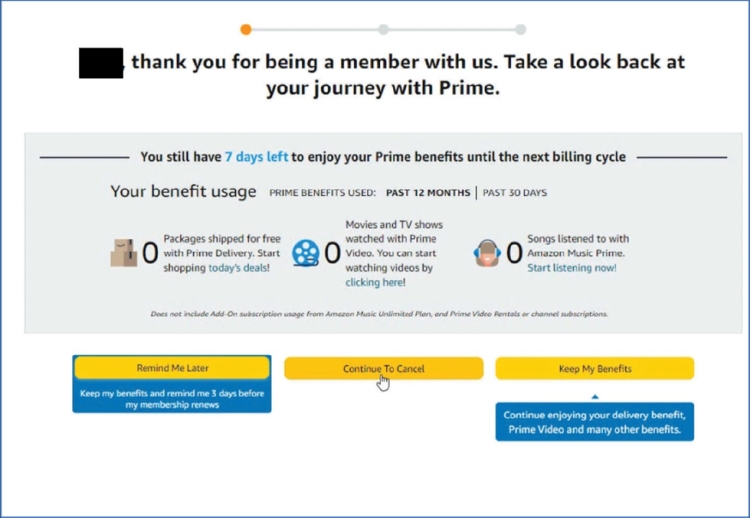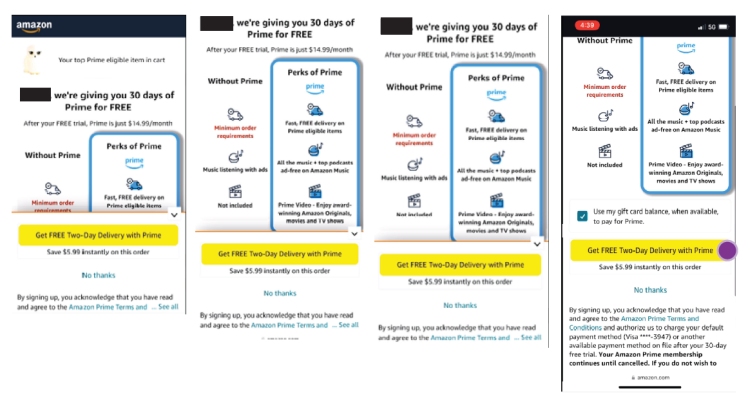- within Consumer Protection topic(s)
Three days into trial, Amazon agreed to pay $2.5 billion to settle a Federal Trade Commission lawsuit alleging that the company misled millions of consumers into subscribing to Amazon Prime and then made it unreasonably difficult for them to cancel in alleged violation of the FTC Act. The settlement is instructive for several reasons: (1) it represents the largest ever obtained by the Ferguson (GOP-led) FTC; (2) it serves as phase one of FTC litigation against Amazon, with a monopolization case to follow in the Western District of Washington; (3) it forms part of a broader litigation campaign against the online retail giant that includes state attorneys general and private class actions; (4) it offers insight into how the FTC will interpret and apply its jurisdiction over "difficult" cancellations, and it marks the first prominent enforcement action in the agency's ongoing campaign against so-called "dark patterns," allegedly manipulative design practices that steer consumers into unintended transactions; and (5) it illustrates how these issues may play out in court, where employees' and contractors' emails featured prominently in the FTC's case. According to a recent Law360 article, the deal has been hailed by the current FTC as a landmark, while former FTC officials are calling it an insufficient penalty.
The FTC Complaint and Trial Evidence Against Amazon
The FTC first filed this case in 2023 during the Biden administration. The FTC Chair at the time, Lina Khan, famously attacked Amazon in a law review article she authored while in law school. The FTC's 2023 complaint alleged that Amazon used "manipulative, coercive, or deceptive" user interface designs to dupe millions of consumers into automatically renewing Prime subscriptions. According to the complaint, Amazon's checkout process repeatedly presented consumers with opportunities to subscribe to Prime, while obscuring the option to decline. On desktop, consumers were shown a prominent button to join Prime, contrasted with a comparatively inconspicuous link to continue the order without it. On mobile devices, disclosures about price and auto-renewal were relegated to the bottom of the page and were viewable only by scrolling. In some instances, consumers were led to believe they were subscribing only to Prime Video, a lower-cost service, but were instead allegedly enrolled in full Prime.
The complaint further alleged that Amazon tricked consumers into signing up for Prime and then, once a consumer was enrolled, Amazon made canceling Prime very hard. Documents at trial described the cancellation process as the "Iliad Flow" – named after the famous Homer epic. Although such tactics are relatively common in face-to-face sales transactions, the FTC has increasingly sought to help consumers avoid them. While the allegations of fraud at sign-up were insubstantial, the evidence on cancellation practices proved far more compelling: Amazon's Prime cancellation process allegedly required consumers to navigate a four-page, six-click, fifteen-option sequence that included repeated diversions, such as discount offers or reminders of Prime benefits.
According to an attorney from the FTC's trial team, whenever Amazon ceased these practices, Prime sign-ups dropped, leading Amazon to quickly "roll back" the changes. During trial, the FTC sought to show the jury that "more members, more money was Amazon goal #1." According to Law360, the FTC's counsel told jurors during opening arguments that, by the company's own estimation, there were more than 35 million "nonconsensual" Amazon Prime enrollments over a seven-year period.
Although no law requires companies to offer an online cancellation option, the FTC alleged that Amazon's methods made cancellation unreasonably difficult. By contrast, enrollment could be accomplished in just two clicks. The FTC alleged that Amazon executives slowed or rejected proposals to simplify cancellation because easier exits hurt subscription revenue. At trial, the FTC attorneys showed that Amazon had calculated the revenue growth achieved by the imposition of each new hurdle to cancellation. Again, while absolutely nothing prevented consumers from cancelling, each new design feature made it more likely that consumers who had subscribed would give up or give in.
Former FTC Chair Lina Khan explained: "Amazon tricked and trapped people into recurring subscriptions without their consent, not only frustrating users but also costing them significant money. These manipulative tactics harm consumers and law-abiding businesses alike. The FTC will continue to vigorously protect Americans from 'dark patterns' and other unfair or deceptive practices in digital markets."
Examples from the FTC's Case
The FTC's complaint provided some screenshots that supposedly illustrated its concerns with Amazon's behavior. We provide those for your information here. None seem individually problematic, but taken together, they formed what the FTC characterized as an unduly burdensome cancellation process:

Figure 1: Screenshot from the FTC's complaint

Figure 2: According to the FTC's complaint, during checkout on mobile, consumers could not view the full text beneath the "No thanks" link without scrolling or clicking the sticky footer arrow.
Amazon's Obligations Under the Settlement
In addition to the $2.5 billion payment, the settlement imposes significant injunctive relief designed to curb the company's alleged use of "dark patterns" in subscription and cancellation flows. Among other things, Amazon must:
- Simplify Prime cancellations: Amazon is prohibited from requiring consumers to navigate difficult, confusing, or time-consuming prompts to cancel their subscriptions. Instead, the company must implement a streamlined, clear, and accessible cancellation process.
- Ban manipulative design practices: Amazon is required to include a clear and conspicuous button for customers to decline Prime. Amazon can no longer have a button that says, "No, I don't want Free Shipping."
- Enhance disclosures: The company is required to present clear, conspicuous information about pricing, renewal terms, and cancellation options at the point of enrollment.
- Compliance monitoring: Amazon must retain an independent third party to monitor Amazon's compliance with the consumer redress distribution process.
Interestingly, the executives named in the settlement incur no direct obligations. The order applies to them for only three years, compared to ten years for the company, and they neither paid monetary penalties nor appear to have lost their positions.
The Bigger Picture: FTC's Focus on Dark Patterns
The Amazon settlement is only the third time the FTC has obtained civil penalties under the Restore Online Shoppers' Confidence Act (ROSCA), but its significance goes well beyond this single case. It reflects a broader regulatory strategy to police digital practices that undermine consumer autonomy, especially in subscription-based markets where recurring charges can generate significant revenue. Notably, the settlement also included two Amazon senior executives, demonstrating the Commission's willingness to hold individuals accountable alongside corporations.
The Amazon case signals that user interface design is now as much a compliance concern as a customer experience consideration. Companies can take a proactive approach by reviewing practices in the following areas:
- Audit enrollment flows. Ensure interfaces present clear, straightforward choices and avoid design elements that could mislead consumers or undermine informed decision-making.
- Obtain clear, affirmative consent. Ensure that any charge results from an explicit, unambiguous action by the consumer. Consent should not be buried in general terms of service, hidden behind hyperlinks, pop-ups, or dropdown menus, or obtained through manipulative design elements.
- Simplify cancellations. A four-page, multi-step cancellation journey is a red flag. Consumers should be able to cancel through the same channel they used to subscribe, without unnecessary steps, delays, or unduly aggressive retention tactics.
- Prioritize transparency. Clearly and conspicuously disclose all material terms, including pricing, auto-renewal conditions, and any obligations or limitations.
- Engage leadership in compliance oversight. The FTC's successful pursuit of liability against Amazon executives underscores the need to educate and involve senior leadership in maintaining robust consumer protection practices.
- Beware the bad email! The emergence of problematic internal emails is a recurring issue in litigation. At trial, the FTC highlighted emails in which engineers opined that the added features made cancelling confusing.
The Amazon settlement highlights the FTC's continued attention to dark patterns. It also suggests the company's strategy to resolve a series of cases, which will culminate in the FTC's upcoming monopolization trial against Amazon. The settlement should be considered within this broader regulatory context.
Amazon responded to our reporting with a statement from spokesperson Mark Blafkin, emphasizing that neither the company nor its executives admitted guilt in the settlement. Blafkin said, "Amazon and our executives have always followed the law and this settlement allows us to move forward and focus on innovating for customers. We work incredibly hard to make it clear and simple for customers to both sign up or cancel their Prime membership, and to offer substantial value for our many millions of loyal Prime members around the world. We will continue to do so, and look forward to what we'll deliver for Prime members in the coming years." Full statement here.
Amazon also noted that the settlement largely requires the company to maintain processes already in place, many of which were implemented years ago. The company stressed that there was no admission of wrongdoing, and explained that it chose to resolve the case to avoid the cost and uncertainty of prolonged litigation and appeals, while continuing to focus on its customers and employees.
The content of this article is intended to provide a general guide to the subject matter. Specialist advice should be sought about your specific circumstances.



